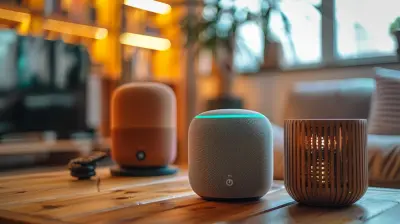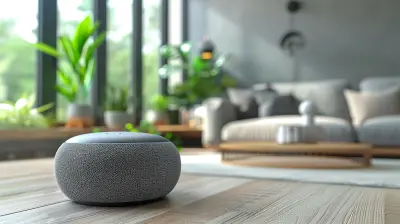Smart Thermostats: Are They Really Saving You Money?
28 April 2025
Who doesn’t love the idea of cutting down utility bills? If you’ve been keeping up with the latest in home automation, you’ve probably heard about smart thermostats. These nifty little devices promise to revolutionize home temperature control, making it more efficient and less costly. But, are they really saving you money, or is it just another tech gimmick?
Let’s break it down and get to the bottom of this. Whether you’re considering purchasing one, or you already have one but are curious if it’s as good as it claims, this article will help you understand the facts.

What Is a Smart Thermostat?
Before we dive into the money-saving aspect, let’s clarify what a smart thermostat actually is. A smart thermostat is a device that connects to your Wi-Fi and allows you to control your home’s heating and cooling systems remotely via a smartphone app, or even through voice commands if integrated with virtual assistants like Alexa or Google Assistant.But that’s not all. Smart thermostats also come with advanced features such as learning your schedule, adjusting based on your preferences, and even optimizing energy use by sensing when you're home or away. They’re like the personal assistants of temperature control—except they’re quiet and don’t need coffee breaks.

The Money-Saving Claims: Fact or Fiction?
Now, the million-dollar question—or maybe the couple hundred dollar question—do smart thermostats really save you money? The short answer is: Yes, they can, but the extent depends on how you use them and your home’s energy efficiency.Let’s get into the specifics.
1. Better Temperature Control
One of the biggest ways smart thermostats can save you money is through better temperature control. Unlike traditional thermostats, which you often have to manually adjust, smart thermostats offer precise control over your heating and cooling systems. You can set schedules, change the temperature remotely, and even let it adjust automatically based on your routines.Think of it like cruise control for your car. Instead of speeding up and slowing down constantly, your thermostat can maintain a more consistent temperature, which uses less energy over time.
2. Learning Your Preferences
Some smart thermostats, like the popular Google Nest Thermostat, come with learning capabilities. These devices track your habits, learning when you’re home or away and adjusting the temperature accordingly. Over time, they can fine-tune your heating and cooling to match your lifestyle, which eliminates wasted energy.Imagine having a butler who knows exactly when you’ll be home and makes sure the house is cozy by the time you walk through the door. That’s what a learning thermostat does, minus the fancy uniforms and British accents.
3. Geofencing Technology
Here’s another cool feature: geofencing. This means the thermostat can detect when you’re away from home based on the location of your smartphone. Once you leave, it automatically adjusts the temperature to save energy. When you’re on your way back, it flips the switch again to make sure your home is comfortable by the time you arrive.Think of it like a smart light that turns off when you leave the room but on a much larger scale. It’s an easy way to avoid wasting energy when you're not at home.
4. Energy Reports
Many smart thermostats provide detailed energy reports showing how much energy you’re using and when. They often offer tips and recommendations for saving more energy. By monitoring your usage, you can identify patterns and make conscious decisions to cut down on your energy consumption.Imagine receiving a monthly report card for your energy use. These insights can be eye-opening, helping you understand where you’re wasting energy and how to fix it.
5. Integration with Other Smart Devices
If your home already has other smart devices, your thermostat can work in tandem with them for even more savings. For example, smart window shades can lower automatically during the hottest part of the day to keep your house cool without cranking up the air conditioning.This interconnected approach to home automation can add up to significant savings, especially if you live in an area with extreme weather conditions.

How Much Can You Actually Save?
Okay, so we’ve established that smart thermostats can save you money, but how much are we talking about here? According to studies and manufacturers, homeowners can save anywhere between 10% to 20% on heating and cooling bills, depending on their usage and the energy efficiency of their home.For instance, if you’re spending $1,200 a year on heating and cooling costs, a 10% savings could net you $120 annually. That might not seem like a lot at first glance, but over the course of several years, it adds up. Plus, the convenience and comfort of having a smart thermostat are hard to put a price tag on.
Real-World Savings
To give you a better sense of potential savings, let’s look at an example.Let’s say you live in a region with cold winters, and your heating bill during the colder months is around $200 per month. If a smart thermostat can reduce your energy usage by 15%, you’re looking at a savings of $30 each month. Over a five-month heating season, that’s $150 in savings.
Now consider the summertime, where you might spend $150 per month on air conditioning. If you save another 10% during the summer, that’s $15 per month, or $45 for a three-month cooling season.
In this example, you’d save a total of $195 in a year—not too shabby for a device that costs around $200 to $300 upfront.

The Upfront Investment: Is It Worth It?
Speaking of cost, let’s talk about the price of smart thermostats. While traditional thermostats can be dirt cheap, smart thermostats usually range from $100 to $300, depending on the model and features. That’s a chunk of change, especially if you’re not sure how much you’ll save in the long run.But think of it as an investment. Yes, the initial cost can be higher, but it can pay off over time in energy savings, especially if you live in an area where heating and cooling costs are substantial. Plus, many utility companies offer rebates and incentives for installing smart thermostats, which can help offset the cost.
So, is it worth it? If you’re someone who’s frequently adjusting the thermostat, or if you’re not always home and need a way to control your HVAC system remotely, then yes—it’s likely worth the investment. If you tend to be more set-it-and-forget-it with your home’s temperature, the savings might not be as significant, but the convenience factor alone could still make it worthwhile.
Are There Any Downsides?
Of course, no gadget is perfect, and smart thermostats have their downsides too. Here are a few to consider:1. Reliance on Wi-Fi
Smart thermostats need a reliable Wi-Fi connection to function optimally. If your internet goes down, you may lose the ability to control your device remotely. While it will still operate as a regular thermostat, some of the smart features will be disabled.2. Complex Installation
Depending on the wiring of your HVAC system, installing a smart thermostat might not be as simple as popping off the old one and plugging in the new one. Some systems, especially older ones, may require additional wiring or even professional installation.3. Privacy Concerns
As with any connected device, there are always privacy concerns. Smart thermostats collect data about your home’s temperature, your habits, and even your location (in the case of geofencing). While manufacturers are typically good about securing this data, it’s something to be aware of.
Final Verdict: Are Smart Thermostats Saving You Money?
So, are smart thermostats really saving you money? The answer is—yes, but with some caveats. If you take advantage of all the features—scheduling, geofencing, learning algorithms, and energy reports—then yes, you can see some noticeable savings on your energy bills.But, if you don’t use those features to their full potential or if your home is already energy efficient, the savings might not be as dramatic. However, the added convenience, comfort, and control over your home’s temperature make smart thermostats a valuable addition to any modern home.
In the end, it comes down to how you use it and whether the upfront cost is worth it for your specific situation. But if you’re serious about saving on your energy bills and reducing your carbon footprint, a smart thermostat is a solid investment.
all images in this post were generated using AI tools
Category:
Gadget ReviewsAuthor:

Marcus Gray
Discussion
rate this article
8 comments
Sawyer McMahan
Smart thermostats: For when you want your home to be as smart as your phone, but without the awkward silences during family gatherings!
May 15, 2025 at 4:04 AM

Marcus Gray
Haha, exactly! Smart thermostats bring convenience without the social awkwardness—plus, they can help save on energy bills too!
Cassandra McIntosh
Smart thermostats promise savings, yet hidden complexities lurk beneath. What if they’re not just energy savers but intricate puppeteers of our consumption habits?
May 14, 2025 at 11:57 AM

Marcus Gray
While smart thermostats can offer savings, their complexity may influence our energy habits in unexpected ways. It’s essential to weigh the benefits against these potential challenges.
Enid White
Great article! Smart thermostats offer significant potential for energy savings by optimizing heating and cooling schedules. While initial costs can be a concern, the long-term savings on utility bills often outweigh these expenses. Consumers should consider their usage patterns to maximize benefits.
May 10, 2025 at 3:00 AM

Marcus Gray
Thank you for your insights! You're absolutely right—smart thermostats can lead to substantial energy savings, and understanding usage patterns is key to maximizing their benefits.
Mason Davis
Smart thermostats are invaluable; they optimize energy use and significantly reduce monthly bills effortlessly.
May 8, 2025 at 11:58 AM

Marcus Gray
Absolutely! Smart thermostats are designed to enhance energy efficiency, leading to noticeable savings on monthly bills with minimal effort required from users.
Kenzie McDowell
Smart thermostats can indeed save you money by optimizing your heating and cooling schedules, learning your habits, and providing energy usage insights. However, the actual savings depend on your home's efficiency and how well you utilize the technology.
May 7, 2025 at 8:39 PM

Marcus Gray
Thank you for your insight! You're absolutely right—savings from smart thermostats can vary based on home efficiency and user engagement.
Theodore Bishop
Smart thermostats can potentially save money by optimizing energy usage, but their effectiveness depends on user habits and installation. Ultimately, they are a tool—wisdom lies in how we use them.
April 29, 2025 at 12:56 PM

Marcus Gray
Absolutely! Smart thermostats are valuable tools for energy savings, but their impact relies on proper installation and user engagement.
McCaw
Great article! Smart thermostats can be a game-changer for energy savings. It's impressive how technology can help us save money and stay comfortable!
April 29, 2025 at 2:20 AM

Marcus Gray
Thank you! I'm glad you found the article insightful. Smart thermostats truly do offer great potential for both comfort and energy savings!
Zoey Perez
Great article! Smart thermostats are such a game-changer. While they can save money, it really depends on how you use them. I love my thermostat!
April 28, 2025 at 7:29 PM

Marcus Gray
Thank you for your feedback! I'm glad to hear you love your smart thermostat—it's all about using it effectively for maximum savings!
MORE POSTS

Portable Powerhouses: The Best Compact Laptops for Productivity

Different Smart Speaker Brands Compared: Which One is Right for You?

Data Breaches: How They Happen and What You Can Do

The Latest in Noise-Canceling Headphones: Top Picks Unveiled

How Smart Speakers Are Changing the Way We Control Our Homes

How to Build Scalable Back-End Architectures for High-Traffic Applications